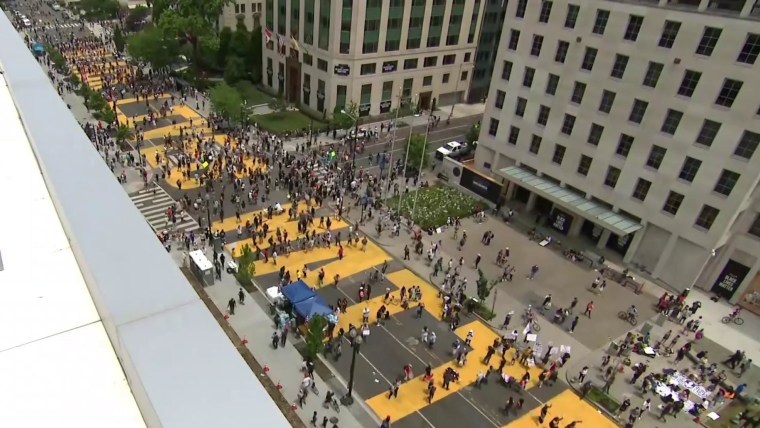WASHINGTON — Thousands of people gathered outside Washington D.C. monuments and the White House on Saturday protesting the killing of George Floyd, years of unanswered calls for police reform and President Donald Trump’s use of the military in response to largely peaceful demonstrations.
“I’m tired of the racism. Just tired,” said Rochelle Grate, a 58-year-old information technology specialist from Fort Washington, Maryland, who described the Saturday protest as “beautiful, peaceful and diverse.”
“This is different,” she said about the protests seen around the country over much of the past two weeks since Floyd, a black man, was killed in police custody in Minneapolis, Minnesota on May 25. “It snapped people not of color to say ‘Man, this is real and I’ve been blind to it.’”
After more than a week of protests in Washington, city officials said they expected Saturday to be the largest demonstration yet with potential for tens of thousands of people taking to the streets.
“We anticipate the largest demonstrations with regards to numbers that we’ve seen in the city to date,” said D.C. Police Chief Peter Newsham at a press conference on Thursday. “And we anticipate that the protesters will continue to be as peaceful as they have been over the past couple of days.”
Newsham said no arrests have been made during protests since Tuesday.
Protests in the District at times turned more violent last weekend as police used tear gas and rubber bullets to disperse demonstrators outside the White House last weekend after some protesters threw water bottles and bricks across a barricade at law enforcement officers. Some protesters set fire to cars and broke the windows of office buildings in the blocks surrounding the White House.
The tension between protesters and law enforcement in Washington peaked on Monday when police and federal officers forcibly removed peaceful protesters from the street across from the White House so President Donald Trump could take a picture in front of St. John’s Episcopal Church, a congregation known as the Church of the Presidents, which was damaged by fire during demonstrations on Sunday.
Let our news meet your inbox. The news and stories that matters, delivered weekday mornings.
Later on Monday, military helicopters were seen flying low over protesters. The D.C. National Guard has opened an investigation into the use of the helicopters.
“I’ve only felt fear once and that was on Tuesday when I went out to vote,” said Tom Roucche, 61, a D.C. resident who said he had to pass through hundreds of law enforcement officers to get to his polling location for the districts primary earlier this week. “I felt we were living … somewhere not the U.S.”
“But I’ve never felt fear in the crowds,” said Roucche. “This has been great to see.”
Pamela Reynolds, a 37-year-old teacher from Washington who protested last weekend, said she could see the difference between Saturday and earlier protests.
“It was scary, heavy. It wasn’t this,” said Reynolds. When asked what changed the atmosphere, Reynolds said it was the arrests of the Minnesota police officers involved in Floyd’s death. “This feels powerful, like it may make a difference.”
“We now have allies,” said Che Washington, 30, a school counselor in D.C., pointing to how diverse the crowd was on Saturday. “Now it feels like everyone is fighting, they’re at least trying. It’s and affirmation to what we’ve been feeling.”
Trump’s actions on Monday motivated even more people to join in peaceful protests outside the White House, with thousands of demonstrators showing up throughout the week to call out aggressive policing tactics, racism and the militant approach the Trump administration has taken in response.
On Thursday the White House erected new fencing around its perimeter, adding to the 8-foot fence that was put up around the entrance to Lafayette Square earlier in the week. The parks immediately surrounding the White House, normally accessible to the public, are expected to remain blocked off until next week.
D.C. Mayor Mayor Muriel Bowser said it was a “sad commentary” that “the house and its inhabitants have to be walled off.”
“We should want the White House to be opened up for people to be able to access it from all sides,” she added.
Many D.C. residents have also expressed anger over Trump’s use of federal forces in the district, complaining that the presence of Humvees, Army helicopters and armed soldiers every few blocks has turned the city into a military zone.
Since D.C. is a territory and not a state, the district does not have the authority to override Trump’s use of the military and other federal forces.
On Friday, Bowser, who has been critical of Trump’s actions, renamed a street in front of the White House “Black Lives Matter Plaza” and had “Black Lives Matter” painted along the road in big yellow letters.
Bowser also took to Twitter on Friday night to ask governors to remove their National Guard from D.C., writing that they were brought “without my knowledge and not at my request.”
Unlike more recent large D.C. protests, such as the recent Women’s March or March for Our Lives, Saturday’s events were not organized by a single group and did not include a formal speaking program with a stage and a microphone.
Instead, protesters moved fluidly through the city, marching from the White House to the Lincoln Memorial to the U.S. Capitol, and back again.
D.C. began blocking off streets downtown as early as 6 a.m. on Saturday in preparation for the events. Protests were expected to continue through Sunday morning.
Although Bowser had put in place a curfew earlier in the week in response to outbreaks of violence, there was no curfew in effect on Saturday.












